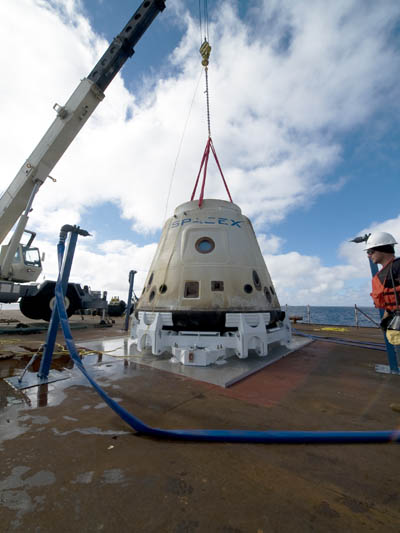Dragon depicted in orbit, with its retractable solar panels. Image courtesy of SpaceX
Tesla founder Elon Musk, who has been striving to lower the cost of space travel via his company SpaceX, has got the go-ahead from NASA to hold a commercial space flight to the International Space Station (ISS) on 7 February 2012, in a move which could open up space travel to us all in time.
Today, NASA confirmed the second Commercial Orbital Transportation Services (COTS) demonstration flight will be on this date, pending the completion of final safety reviews, testing and verification.
NASA has also has agreed to allow SpaceX to send its Dragon spacecraft to the ISS in a single flight.
But what is Dragon exactly? It’s a free-flying, reusable spacecraft being developed by SpaceX under NASA’s COTS programme. Initiated by SpaceX in 2005, the Dragon craft is made up of a pressurised capsule and unpressurised trunk used to transport pressurised cargo, unpressurised cargo, and/or crew members.
In December 2008, NASA announced its selection of SpaceX’s Falcon 9 launch vehicle and the Dragon craft to resupply the ISS when the space shuttle programme retires. The US$1.6bn contract will represent a minimum of 12 flights.
Dragon already made history when it became the first commercially owned aircraft to go into orbit last December.

The SpaceX crew brings Dragon back to the barge. A crane lifts it from the water after Dragon went into orbit last year. Credit: SpaceX/Mike Altenhofen
The person behind SpaceX is Elon Musk, who is best known for having founded Tesla, the California company that pioneered the swish Tesla Roaster all-electric vehicle back in 2008.
Dragon‘s key features
- Dragon can hold seven crew members.
- It is designed for water landing under parachute for ocean recovery
- It features solar panels that generate 4,000 watts of power when the aircraft is in orbit
- Its heat shield provides thermal protection on re-entry into the Earth’s atmosphere
During the upcoming 7 February flight, Dragon will conduct a series of check-out procedures that will test and prove its systems in advance of the “rendezvous” with the ISS, according to the space agency.
The primary objectives for the flight include:
- A fly-by of the space station at a distance of circa 3.2 kilometres to validate the operation of sensors and flight systems necessary for a safe rendezvous and approach.
- The spacecraft will also demonstrate the capability to abort the rendezvous, if required.
Docking at the ISS
NASA has confirmed that Dragon will perform the final approach to the ISS while the station crew “grapples” the vehicle with the station’s robotic arm.
At the end of the mission, the crew will reverse the process, detaching Dragon from the station for its return to Earth and splashdown in the Pacific off the coast of California.
If the rendezvous and attachment to the station are not successful, NASA said SpaceX will complete a third demonstration flight in order to achieve these objectives.
“SpaceX has made incredible progress over the last several months preparing Dragon for its mission to the space station,” said William Gerstenmaier, NASA’s associate administrator for the Human Exploration and Operations Mission Directorate, yesterday. “We look forward to a successful mission, which will open up a new era in commercial cargo delivery for this international orbiting laboratory.”
He said a “significant amount of critical work” still needs to be completed before launch, but added that the teams have a “sound plan to complete it and are prepared for unexpected challenges”.
“As with all launches, we will adjust the launch date as needed to gain sufficient understanding of test and analysis results to ensure safety and mission success,” added Gerstenmaier.
Alan Lindenmoyer, programme manager for COTS at NASA’s Johnson Space Center in Houston, pointed to how SpaceX is pivotal in demonstrating how a partnership between the government and private industry can lead to new capabilities for space missions.
The future of space mobility …
Initiated in 2006, NASA’s COTS programme is investing financial and technical resources to stimulate efforts within the private sector to develop and demonstrate safe and cost-effective space transportation capabilities.
Through Space Act Agreements, SpaceX will receive up to US$396m and Orbital Sciences Corporation, NASA’s other COTS partner, will receive up to US$288m for the successful completion of all milestones in the agreements.
To date, SpaceX has received US$376m for completing 36 out of 40 milestones, and Orbital has received US$261.5m for completing 23 out of 29 milestones.